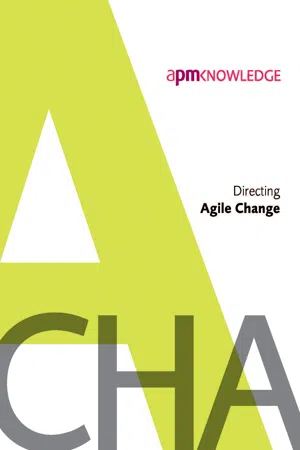
- English
- ePUB (mobile friendly)
- Available on iOS & Android
Directing Agile Change
About this book
"Agile working is increasingly recognised by organisations as a competitive advantage, where a speedier but controlled response is needed to changing environmental conditions. How should organisations oversee the delivery of agile projects? This guide provides the answer."Jennifer Stapleton, foreword author.Directing Agile Change is the latest offering from APM's Governance Specific Interest Group (SIG).Written by SIG members Brian Wernham, Adrian Pyne, Roger Garrini and Martin Samphire, this latest guidance is aimed at those involved in the governance of all change initiatives, with an emphasis on those at senior level – board members, sponsors and stage gate reviewers etc.Divided into five main sections, the guide covers the main principles of agile governance, when to adopt an agile approach and, importantly, how to gain the most value from being agile. Also included are checklists to adopt and key questions to ask.Directing Agile Change is the first 'how to' agile guide published by APM. It seeks to recognise that agile is not limited to software development but can also be applied to many aspects of an organisation.
Frequently asked questions
- Essential is ideal for learners and professionals who enjoy exploring a wide range of subjects. Access the Essential Library with 800,000+ trusted titles and best-sellers across business, personal growth, and the humanities. Includes unlimited reading time and Standard Read Aloud voice.
- Complete: Perfect for advanced learners and researchers needing full, unrestricted access. Unlock 1.4M+ books across hundreds of subjects, including academic and specialized titles. The Complete Plan also includes advanced features like Premium Read Aloud and Research Assistant.
Please note we cannot support devices running on iOS 13 and Android 7 or earlier. Learn more about using the app.
Information
- within projects and/or programmes (referred to hereafter as ‘projects’);
- across the organisational environment of projects (referred to hereafter as ‘enterprise project management’).


- having a consistent method for incremental delivery at the heartbeat of the business, not at the convenience of the project team;
- evolving solutions with stakeholders;
- building teams with accountability and authority to benefit the business;
- maintaining alignment of development activities and product releases with strategic business objectives.
Myth | Reality |
Agile is only for stars. | Agile working produces best value when there are capable agile project teams, operating in a supportive agile landscape. To gain value from agile governance, organisations need to invest in it. |
Agile does not fit our culture. | Wh... |
Table of contents
- Copyright Page
- Contents
- Figures and tables
- Foreword
- Acknowledgements
- Chapter 1. Context and introduction
- Chapter 2. Principles of agile governance
- Chapter 3. When to adopt an agile approach
- Chapter 4. Gaining value from agile
- Chapter 5. Governance guidance lists
- Appendix A: References and further information
- Appendix B: Compendium of agile development methods
- Back Cover